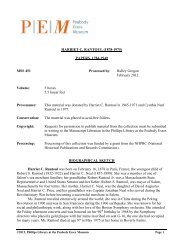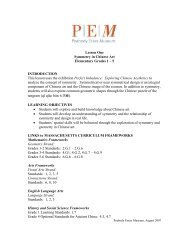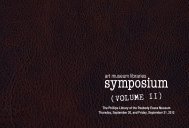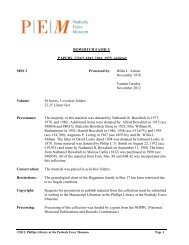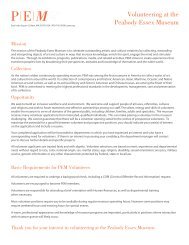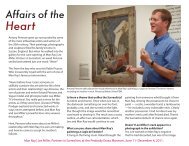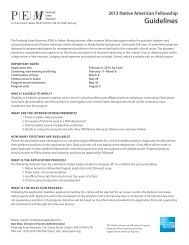Explore The Watery World Of The Ancient Maya - Peabody Essex ...
Explore The Watery World Of The Ancient Maya - Peabody Essex ...
Explore The Watery World Of The Ancient Maya - Peabody Essex ...
You also want an ePaper? Increase the reach of your titles
YUMPU automatically turns print PDFs into web optimized ePapers that Google loves.
What is<br />
this fi gure<br />
doing?<br />
What is this<br />
man wearing<br />
around his<br />
neck?<br />
Water and the<br />
<strong>Ancient</strong> <strong>Maya</strong><br />
Water infl uenced all aspects of ancient<br />
<strong>Maya</strong> life. Surrounded by the sea,<br />
the <strong>Maya</strong> imagined their home — the<br />
Yucatan Peninsula region — as a great<br />
turtle fl oating in the ocean. <strong>The</strong>y used<br />
sea turtles, crocodiles and other animals<br />
as symbols of water and the water cycle<br />
in their art. <strong>The</strong> <strong>Maya</strong> also worshiped<br />
powerful gods such as the God of Rain,<br />
Chahk, and the Sun God, who made a<br />
journey across the sky each day. When<br />
the sun rose from the Caribbean Sea and<br />
set in the Gulf of Mexico, the refl ected<br />
glow made the sea look like a “fi ery<br />
pool.”<br />
<strong>Explore</strong> the important role of water in<br />
everyday <strong>Maya</strong> life using this Gallery<br />
Discovery Kit. Get ready for a watery<br />
journey through Fiery Pool: <strong>The</strong><br />
<strong>Maya</strong> and the Mythic Sea.<br />
<strong>The</strong>re’s more to do at PEM!<br />
At PEM, we’ve got plenty of ways for you to discover new<br />
adventures in art with your family and friends. Visit the Art<br />
& Nature Center, an interactive exhibition space designed<br />
especially for families. <strong>Explore</strong> the museum with a<br />
guided tour designed just for families. Get swept up in the<br />
excitement of an Atrium Alive weekend festival and make<br />
new friends at one of our story time programs.<br />
East India Square | Salem, MA 01970 USA | 978-745-9500 | pem.org<br />
Plate with the Maize God dancing above water, 700–800, Peten region, Guatemala.<br />
Princeton University Art Museum. Photo by Bruce M. White. | Vessel with the Hunter<br />
God blowing a conch (detail), 700–800, Puuc region, Mexico. Dumbarton Oaks, Pre-<br />
Columbian Collection, Washington, D.C. Photo © Dumbarton Oaks, Pre-Columbian<br />
Collection, Washington, D.C. | Carving of a frog, 700–800, Topoxte, Guatemala. Ministerio<br />
de Cultura y Deportes–Museo Nacional de Arqueología y Etnología, Guatemala City.<br />
Courtesy <strong>Peabody</strong> <strong>Essex</strong> Museum. Photo © 2009 Jorge Pérez de Lara. | Sculpture of<br />
Chahk, 800–900, Campeche or Yucatan, Mexico. <strong>The</strong> Metropolitan Museum of Art, New<br />
York, Harris Brisbane Dick Fund. Photo © <strong>The</strong> Metropolitan Museum of Art. | Lidded vessel<br />
with the Sun God paddling across the aquatic fl oral road, 200–450, Mexico or Guatemala.<br />
Dallas Museum of Fine Arts. | Figurine of a lord, 700–800, Jaina Island, Mexico National<br />
Museum of the American Indian, Smithsonian Institution, Washington, D.C. Photo K2834<br />
© Justin Kerr. | Sculpture of a world-crocodile, 300 BC–AD 100, Kaminaljuyu, Guatemala.<br />
Ministerio de Cultura y Deportes–Museo Nacional de Arqueología y Etnología,<br />
Guatemala City. Courtesy <strong>Peabody</strong> <strong>Essex</strong> Museum. Photo © 2009 Jorge Pérez de Lara.<br />
| Lidded vessel with water-birds and Oliva shell tinklers, 600–700, Peten, Guatemala.<br />
<strong>The</strong> Jay I. Kislak Collection at the Library of Congress, Rare Book and Special Collections<br />
Division, Washington, D.C. Photo K6218 © Justin Kerr. | Match the Glyphs: <strong>The</strong> <strong>Maya</strong> word<br />
for turtle, ahk. Drawing by Nick Carter. | <strong>The</strong> <strong>Maya</strong> word for shark, xook. Drawing by Karl<br />
A. Taube. | <strong>The</strong> <strong>Maya</strong> word for fi sh, kay or chay. Drawing by Nick Carter.<br />
This exhibition was made possible in part by the National Endowment for the Humanities:<br />
Because democracy demands wisdom. Additional support provided by ECHO (Education<br />
through Cultural and Historical Organizations). Exhibition supported by an indemnity<br />
from the Federal Council on the Arts and the Humanities.<br />
MEDIA PARTNER<br />
EXPLORE THE<br />
WATERY WORLD<br />
OF THE ANCIENT MAYA<br />
G A L L E R Y D I S C O V E R Y K I T<br />
How to use this<br />
Gallery Discovery Kit<br />
Get ready for a<br />
<strong>Maya</strong> adventure!<br />
1 Unfold the booklet completely<br />
and fi nd two discovery cards at<br />
each end.<br />
2 Read the clue on the front of each<br />
card and seek out the object in<br />
the Fiery Pool exhibition.<br />
3 Once you fi nd the art, fl ip the card<br />
over to discover cool facts and fun<br />
things to explore!<br />
What animal<br />
does this look<br />
like to you?<br />
What are<br />
these birds<br />
up to?
ANSWER<br />
It’s a crocodile! To the <strong>Maya</strong>, a crocodile drifting in the water looked like the<br />
earth’s surface surrounded by ocean. <strong>The</strong> <strong>Maya</strong> believed crocodiles created<br />
clouds, wind and even rain.<br />
LOOK CLOSELY<br />
This object was carved out of stone around 2,000 years ago. When it<br />
was found about 100 years ago, the snout and the end of the tail were<br />
missing. Can you imagine what these parts might have looked like?<br />
EXPLORE<br />
Can you fi nd other crocodiles in this gallery? Look for one that is painted<br />
blue. It is both a whistle and a rattle!<br />
ANSWER<br />
<strong>The</strong>y are fi shing with their beaks for something to eat!<br />
LOOK CLOSELY<br />
<strong>The</strong> olive-shaped designs on the jar<br />
and lid are most likely Oliva shells.<br />
<strong>The</strong> <strong>Maya</strong> used these shells as<br />
decoration on clothing. When<br />
strung together the shells knocked<br />
against each other and sounded like<br />
the ocean. What would you use to<br />
make a sound like the ocean?<br />
EXPLORE<br />
Shells inspired <strong>Maya</strong> artists to create<br />
many types of objects. Can you fi nd a<br />
small frog carved out of Oliva shell in<br />
this gallery?<br />
Follow<br />
the Maze<br />
<strong>The</strong> <strong>Maya</strong> believed conchs<br />
could speak directly with<br />
humans. Conchs also<br />
represented breath or wind.<br />
END HERE<br />
Follow the maze through<br />
this decorated conch shell<br />
to let a message or breath<br />
get out.<br />
You can find the conch<br />
trumpet that inspired this<br />
maze in the exhibition.<br />
START HERE<br />
MEXICO<br />
PACIFIC OCEAN<br />
GULF OF MEXICO<br />
Home of the <strong>Maya</strong><br />
<strong>The</strong> <strong>Maya</strong> lived in the Yucatan Peninsula region of<br />
Mexico and Central America, starting in 500 B.C.<br />
at the latest. (That’s over 2,500 years ago!)<br />
YUCATAN PENINSULA REGION<br />
Match the Glyphs<br />
<strong>The</strong> <strong>Maya</strong> invented an advanced writing system made<br />
up of about 800 signs, or “glyphs.” <strong>The</strong>se signs were<br />
combined to form “glyph blocks.” Some signs were<br />
syllables and others were whole words.<br />
Below are three <strong>Maya</strong>n word glyphs, each representing a<br />
water animal. Can you match each glyph with a picture?<br />
SHARK: 3, TURTLE: 1, FISH: 2<br />
ANSWER<br />
This is the Sun God paddling a canoe across<br />
the sky on his daily journey. <strong>The</strong> <strong>Maya</strong><br />
believed the Sun God rose out of the sea<br />
in the east each morning and returned<br />
to the watery Underworld in the west<br />
at sunset.<br />
LOOK CLOSELY<br />
Do other things on this<br />
vessel remind you of water?<br />
EXPLORE<br />
Look for more canoes in this<br />
gallery. What do you see people<br />
doing in these canoes?<br />
ANSWER<br />
He is wearing a spiny oyster shell pendant.<br />
LOOK CLOSELY<br />
Spiny oyster (or Spondylus) shells were<br />
believed to house the spirits of <strong>Maya</strong><br />
ancestors. By wearing this shell, a ruler<br />
combined his own life force with that<br />
of an honored ancestor.<br />
EXPLORE<br />
Can you fi nd other shell pendants in this<br />
gallery? Are they similar to or different from<br />
the spiny oyster shell pendant?



